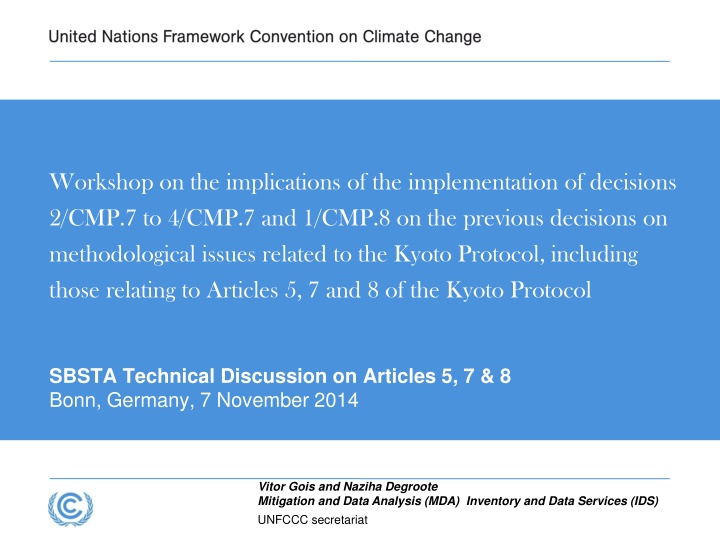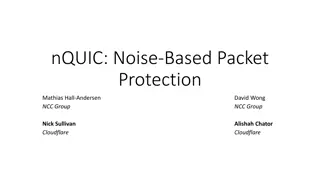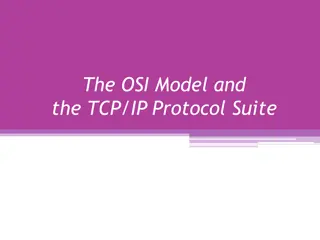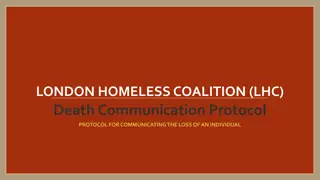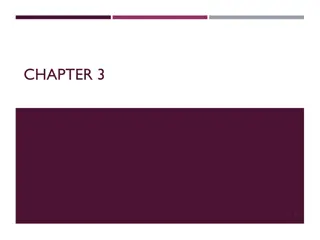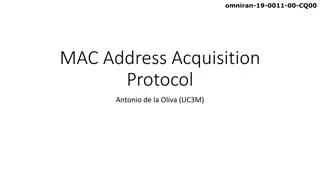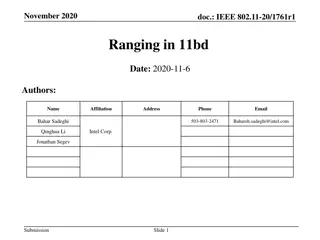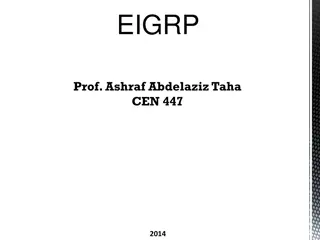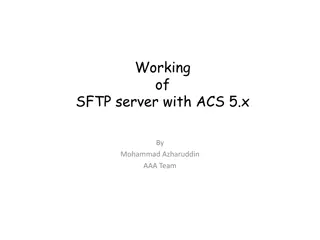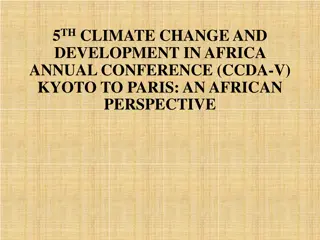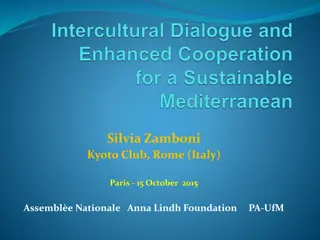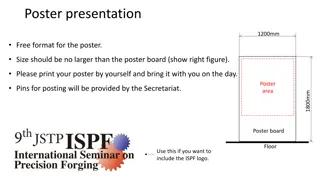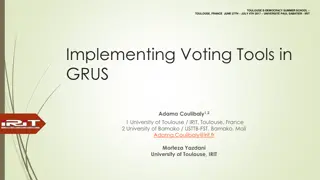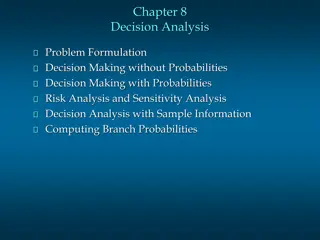Implications of Decision Implementation on Kyoto Protocol Methodological Issues
This content discusses the implications of decisions 2/CMP.7 to 4/CMP.7 and 1/CMP.8 on methodological issues related to the Kyoto Protocol, specifically focusing on Articles 5, 7, and 8. It provides an overview of the status of the work as of June 2014, details the mandate initiation at SBSTA 36, and highlights the status of work as of June 2014 pertaining to Decision 2/CMP.8 and Decision 6/CMP.9. The discussions aim to assess and address the implications of these decisions for the Kyoto Protocol. Various technical discussions and assessments were conducted during workshops and meetings in Bonn, Germany, in November 2014.
Download Presentation

Please find below an Image/Link to download the presentation.
The content on the website is provided AS IS for your information and personal use only. It may not be sold, licensed, or shared on other websites without obtaining consent from the author.If you encounter any issues during the download, it is possible that the publisher has removed the file from their server.
You are allowed to download the files provided on this website for personal or commercial use, subject to the condition that they are used lawfully. All files are the property of their respective owners.
The content on the website is provided AS IS for your information and personal use only. It may not be sold, licensed, or shared on other websites without obtaining consent from the author.
E N D
Presentation Transcript
Workshop on the implications of the implementation of decisions 2/CMP.7 to 4/CMP.7 and 1/CMP.8 on the previous decisions on methodological issues related to the Kyoto Protocol, including those relating to Articles 5, 7 and 8 of the Kyoto Protocol SBSTA Technical Discussion on Articles 5, 7 & 8 Bonn, Germany, 7 November 2014 Vitor Gois and Naziha Degroote Mitigation and Data Analysis (MDA) Inventory and Data Services (IDS) UNFCCC secretariat
Overview of the status of the work as of June 2014 (SBSTA 40) SBSTA Technical Discussion on Articles 5, 7 & 8 Bonn, Germany, 7 November 2014 Vitor Gois and Naziha Degroote Mitigation and Data Analysis (MDA) Inventory and Data Services (IDS) UNFCCC secretariat
Mandate Initiation of the work at SBSTA 36 (requested by CMP7, Durban) Initial work to assess and address the implications of the implementation of decisions 2/CMP.7 to 5/CMP.7 on the previous CMP decisions on methodological issues related to the Kyoto Protocol, including those relating to Articles 5, 7 and 8. Decision 2/CMP8 Continuation by SBSTA to assess and address the implications of the implementation of decisions 2/CMP.7 to 4/CMP.7, as well as those of decision 1/CMP.8, on the relevant decisions adopted for the first commitment period. Continuation of the work agreed by SBSTA 40 SBSTA 40 agreed to continue its consideration of this agenda item at SBSTA 41 with a view to finalizing draft decisions for consideration and adoption at CMP 10.
Status of work as at June 2014 Decision 2/CMP.8 : defined the timing and content of the report to facilitate the calculation of the assigned amount for the second commitment period defined the information relating to the reporting of KP- LULUCF activities that needs to be submitted together with the annual GHG inventory in CP2 Time of submission of the 1st SEF tables for CP2
Status of work as at June 2014 Decision 6/CMP.9 : adopted the guidance for submission of information on anthropogenic GHG emissions by sources and removals by sinks from LULUCF activities under Article 3, paragraphs 3 and 4, pursuant to Article 5, paragraph 2, of the Kyoto Protocol in the second commitment period, including the common reporting format (CRF) tables for KP-LULUCF activities
Status of work as at June 2014 Progress of negotiations: Warsaw: CMP 9 requested SBSTA to continue consideration of the relevant implications on the basis of the In-session discussion text relating to item 12(a) of SBSTA 39 and item 3(a) of CMP 9 ; Bonn: SBSTA 40 agreed to continue to work on the basis of: the in-section discussion text (Warsaw), and the text contained in the Note by the co-facilitators elements of text relating to review and adjustment
Status of work as at June 2014 The in-session discussion text covers: References regarding CMP 1 decisions 13, 15, 18 and 19 Addresses issues related to the report to facilitate the calculation of the assigned amount Proposed the adoption of: Revision to the modalities for the accountings of AA, including Calculation of the AA pursuant to Article 3.7bis, 8 and 8bis Cancellation pursuant to 3.7ter Share of proceeds CAD and ITL SEF tables and instructions, registry requirements and additions and subtractions from the Assigned Amount (decision 14/CMP.1) Revisions to the guidelines for the preparation of the information required under Article 7 (decision 15/CMP.1) Extends the code of practice for the treatment of confidential information for reviews
Status of work as at June 2014 Note by the co-facilitators covers : References regarding decisions 20/CMP.1 and 22/CMP.1 Review guidelines under Article 8 Issues related to the review of the report to facilitate the calculation of the AA Issues related to the review of national system and national registry The Standard Independent Assessment Report in the review guidelines Adjustments under Article 5, para. 2, of the Kyoto Protocol
Status of work as at June 2014 - Overview Negotiations progress and issues not yet adopted Covered in the in-session discussion text (SBSTA 39/CMP 9) Covered in the note by the co- facilitators (SBSTA 40)b Decision(s) already adopted Decision at CMP 10 needed? Outstanding issues to be discussed Implications References to Articles of the Kyoto Protocol, methodologies of the Intergovernmental Panel on Climate Change and decisions, and any other consequential changes related to references Yes (presentation on the technical paper) 1/CMP.8 2/CMP.8 6/CMP.9 Yes Yes Yes Calculation of the initial assigned amount and the review of the initial report to facilitate the calculation of the assigned amount for the second commitment period Yes (presentation on the technical paper) 2/CMP.8 Yes Yes Yes Yes (presentation on the technical paper) Carry-over and previous period surplus reserve accounts 1/CMP.8 Yes No Yes
Status of work as at June 2014 - Overview Negotiations progress and issues not yet adopted Covered in the in-session discussion text (SBSTA 39/CMP 9) Covered in the note by the co- facilitators (SBSTA 40) Decision(s) already adopted Decision at CMP 10 needed? Outstanding issues to be discussed Implications Yes (presentation on the technical paper) Article 3, paragraph 7 ter, in the Doha Amendment 1/CMP.8 Yes No Yes Yes (presentation on the technical paper) Share of proceeds 1/CMP.8 Yes No Yes Increases in ambition as referred to in decision 1/CMP.8, paragraphs 7 and 8, and Article 3, paragraphs 1 ter and 1 quater, in the Doha Amendment 1/CMP.8 Yes No Yes
Status of work as at June 2014 - Overview Negotiations progress and issues not yet adopted Covered in the in-session discussion text (SBSTA 39/CMP 9) Covered in the note by the co- facilitators (SBSTA 40) Decision(s) already adopted Decision at CMP 10 needed? Outstanding issues to be discussed Implications Land use, land-use change and forestry issues not covered in decisions 2/CMP.8 and 2/CMP.7 or the common reporting format tables 2/CMP.8 6/CMP.9 No No No Clarification of reporting requirements for Parties included in Annex I to the Convention without a quantified emission limitation and reduction commitment for the second commitment period Yes (presentation on the technical paper) 2/CMP.8 Partly Partly Yes
Status of work as at June 2014 - Overview Negotiations progress and issues not yet adopted Covered in the in-session discussion text (SBSTA 39/CMP 9) Covered in the note by the co- facilitators (SBSTA 40) Decision(s) already adopted Decision at CMP 10 needed? Outstanding issues to be discussed Implications Yes (presentation on the technical paper) Implications for the Guidelines for review under Article 8 of the Kyoto Protocol No Partly Yes Update of conservativenes s factors and use of the 2006 IPCC Guidelines addressed in the technical paper Implications for adjustments under Article 5, paragraph 2, of the Kyoto Protocol No Partly Yes
Introduction of the technical paper SBSTA 40 conclusions, para. 137(a)
Mandate for the updated technical paper Technical paper - FCCC/TP/2014/6 To facilitate the finalization of the work for consideration at CMP 10, SBSTA 40 requested the secretariat to update and extend the technical paper FCCC/TP/2013/9 : reflecting the status of work as at June 2014, addressing the update of the conservativeness factors contained in appendix III to the annex to decision 20/CMP.1, reflecting any submissions from Parties on related matters.
Previous versions of the technical paper Technical paper - FCCC/TP/2012/6 SBSTA 36 requested the secretariat to prepare a technical paper that includes a comprehensive identification of such implications. Technical paper - FCCC/TP/2013/9 Technical paper mandated by SBSTA 38 and reflecting the progress achieved through the adoption of decisions 1/CMP.8 and 2/CMP.8 Technical paper - FCCC/TP/2014/6 Available at : <http://unfccc.int/resource/docs/2014/tp/06.pdf>
Scope of the update of the technical paper The previous technical paper (FCCC/TP/2013/9) reflects the progress achieved by adoption of decision 2/CMP.8. The present technical paper focuses on reflecting the progress in the negotiations achieved through decision 6/CMP.9 and the in-session text and the note by the co-facilitators Distinction is made between : the issues resolved by the adoption of decisions 2/CMP.8 and 6/CMP.9, and the issues advanced but not yet adopted (the in-session discussion text and the note by the co-facilitators from SBSTA 40)
Contents and structure of the technical paper Technical paper FCCC/TP/2014/6 addresses: Addressing references (decisions, Articles of KP, IPCC methodologies, etc) Substantive implications of decisions 2/CMP.7 to 4/CMP.7, 1/CMP.8 and 2/CMP.8. The following subsections were updated: Calculation of the initial assigned amount and review of the report to facilitate the calculation of the assigned amount Carry-over and previous period surplus reserve accounts (PPSR) Article 3, paragraph 7 ter Share of proceeds; Any increases in ambition related to Article 3, paragraphs 1 ter and 1 quater LULUCF issues not covered in decisions 2/CMP.8 and 2/CMP.7 (no pending issues) Clarification of reporting and review requirements for Parties included in Annex I to the Convention (Annex I Parties) without a QELRC for CP2
Contents and structure of the technical paper Technical paper FCCC/TP/2014/6 addresses new issues: The relevant implications for the review process under Article 8 of the Kyoto Protocol; The issues relating to adjustments and conservativeness factors. The issues relating to training programme established under decision 8/CMP.5
References The approach for addressing references has been consistent in adopted decisions (2/CMP.8 and 6/CMP.9) and working documents Defining general changes and updates in the overarching part of the decisions Identifying changes to specific references in the annexes whenever these apply to a single previous decision Progress has been made in identifying the remaining consequential changes to references both the in-session discussion text and the note by the co- facilitators
References However, the TP identify 3 additional updates of references to ensure full comprehensiveness: In paragraph 3 of the note by the co-facilitators, decisions 18/CMP.1, 19/CMP.1, 20/CMP.1 and 22/CMP.1 should be included in the update of references identified under that paragraph; In paragraph 69(b) of the annex to decision 22/CMP.1, the reference to the IPCC Good Practice Guidance and Uncertainty Management in National Greenhouse Gas Inventories (hereinafter referred to as the IPCC good practice guidance) should be replaced by a reference to the 2006 IPCC Guidelines; In paragraph 14(a) of the annex to decision 19/CMP.1, the reference to chapter 7, paragraph 7.2, of the IPCC good practice guidance should be replaced by a reference to chapter 4.3 of the 2006 IPCC Guidelines.
Calculation of the initial assigned amount Decisions and the in-session document have addressed some related issues: Report to facilitate the calculation (decision 2/CMP.8) Calculation of the AA pursuant to Article 3, paragraphs. 7 bis, 8 and 8 bis; Cancellation pursuant to Article 3, para. 7 ter; Recording of the assigned amounts Additions/subtractions from, the AA and basis for the compliance assessment Share of proceeds Carry over and previous period surplus reserve accounts (PPSR)
Calculation of the initial assigned amount Issues that may need to be addressed relate to: Review of these issues in the modalities of the review of the report to facilitate the calculation of the assigned amount and implications on adjustments Information to be reviewed
Review guidelines and adjustments Proposals related to review and adjustments are included in the note by the co-facilitators: Review of the report to facilitate the calculation of the initial assigned amount; Review of national system and national registry; The use of SIAR reports in reviews.
Review guidelines: UNFCCC review guidelines UNFCCC guidelines for technical review of GHG inventories from Annex I Parties The review guidelines under the Convention and those under the Kyoto Protocol cover common areas such as: Organization of reviews (desk reviews, centralized reviews and in-country reviews) The scope of the review phases, and The timing of the reviews. Submission by Parties: Any agreement under the Convention should also apply under the Kyoto Protocol; Keeping the same approach to organizing the reviews would allow inventory reviews under the Convention to continue to be conducted in conjunction with those under the Kyoto Protocol; When addressing procedural issues, the KP review guidelines should only refer to the review guidelines under the Convention review guidelines.
Review guidelines: identified issues for consideration The technical paper and submissions by Parties identified the following issues for particular consideration Objectives; Expert review teams, including the composition, competencies and role of experts and lead reviewers The role of the secretariat; General procedures; periodicity of the reviews; The stages; The scope, timing and reporting procedures for each review stage; Timing and procedure of the initial review; Issues related to the review of national inventory systems and national registries and adoption of decision 9/CMP.9 (national communications); Adjustments: see next presentation;
Reporting requirements for Annex I Parties without QELRC for CP2 Some CMP decisions have clarified the scope of the application of the provisions: Report to facilitate the calculation of the assigned amount; Calculation of the assigned amount and linked calculations; SEF tables; Reporting on LULUCF activities; The national system in accordance with Article 5, paragraph 1; Methodologies for estimating emissions/removals and global warming potentials; The scope of participation in market-based mechanisms (Decision 1/CMP.8).
Reporting requirements for Annex I Parties without QELRC for CP2 Issues for further consideration: Article 3, paragraph 1 bis: the overall emissions; Article 3, paragraphs 1 ter and 1 quarter; Article 3, paragraph 7 ter; Applicability and calculation of the CPR Carry-over of units to subsequent commitment periods Provisions related to registry requirements, the issuance of removal units (RMUs) and the cancellation of units
Reporting requirements for Annex I Parties without QELRC for CP2 Issues for further consideration (cont.) Submission of supplementary information required under Article 7 of the Kyoto Protocol, including: Information on ERUs, CERs, RMUs and AAUs not reported in a SEF table: decision 15/CMP.1, annex, paragraphs 12 20; Changes in national systems; (Changes in national registries; Minimization of adverse impacts in accordance with Article 3, paragraph 14; Reporting of supplementary information under Article 7, paragraph 2; The modalities for review and the calculation of adjustments
Update of the conservativeness factors methodology and results
Conservativeness factors Use of the conservativeness factors (para. 54 of the annex to decision 20/CMP.1) To ensure conservativeness for the purpose of adjustments, a conservativeness factor should be applied to the specific component of the estimation method used by the Party or to the emission/removal estimate generated by the basic adjustment methods described in section III.A of this technical guidance. For illustration purposes, this approach may be expressed as: M CF = Adjusted estimate Where M is the component of an estimation method used by a Party, or the emission or removal estimate generated by a basic adjustment method in this technical guidance, and CF is the conservativeness factor.
The need for the update in conservativeness factors Taking into consideration: Revised categories and GHGs Revised UNFCCC reporting guidelines; decision 4/CMP.7 The use of the new IPCC Guidelines, as implemented in accordance with decisions 24/CP.19 and 6/CMP.9 2006 IPCC Guidelines, IPCC 2013 Revised Supplementary Methods 2013 Wetlands report Revised rules on KP-LULUCF activities arising from decisions 2/CMP.7 and 6/CMP.9
Overview of the methodology The conservativeness factors for EFs and AD are derived from the IPCC Guidelines, using, in some cases, rules for experts judgment, such as: Uncertainties for tier 1 are preferred ; If the IPCC Guidelines provide an uncertainty range, the maximum uncertainty is used; For some subcategories, a combined uncertainty range for calculated from the uncertainty values and/or ranges of the input parameters using tier 1 (e.g. solid waste disposal); In cases other cases an assessed uncertainty range is determined taking into consideration the uncertainty ranges available for other subcategories. CF for emissions calculated from uncertainties for AD and EF using the error propagation rules (equation 3.1 of chapter 3 of 2006 IPCC Guidelines)
Overview of the methodology The Technical Paper followed a similar approach to decision 20/CMP.1 CF are based on the 25 and 75 percentile of the range of uncertainty values Limited number of uncertainty values: uncertainty values and corresponding CF have been grouped into five sets of uncertainty bands CFs for a category may be defined by using the most stringent available CFs for its subcategories This CF for the category may be used for the subcategories for which no uncertainty values were available (e.g. other categories) or if the used of detailed CF for sub-categories is not used
Assigned Uncertainty Band and possible conservativeness factors Assigned CF for emissions in the BY and/or removals in a year of the CP CF for emissions in a year of the CP and/or removals in the BY Estimated uncertainty range uncertainty band (%) (%) <= 10 7 0.98 1.02 10 > and <= 30 20 0.94 1.06 30 > and <= 50 40 0.89 1.12 50 > and <= 100 75 0.82 1.21 > 100 150 0.73 1.37
Overview of the methodology Revision of the category/subcategory In accordance with CRF tables structure and 2006 IPCC guidelines Determination of the uncertainty values In accordance with the IPCC for EF and AD Guidelines In accordance with error Calculation of the emissions uncertainty propagation rules Determination of the Uncertainty In accordance with table 1 in the Assigned Band Technical Paper Conservativeness factors for base year and CP year
Results: tables with proposed conservativeness factors Tables included in Annex II in the Technical paper, correspond to different cases of adjustments: Table 3: BY for sources in Annex A to the KP Table 4: year of CP for sources in Annex A Table 5: net emissions for the LULUCF sector during the initial review Table 6: net removals for the LULUCF sector during the initial review Table 7: KP-LULUCF activities: removals in a year of CP and emissions in BY Table 8: KP-LULUCF activities: emissions in a year of CP and removals in BY
